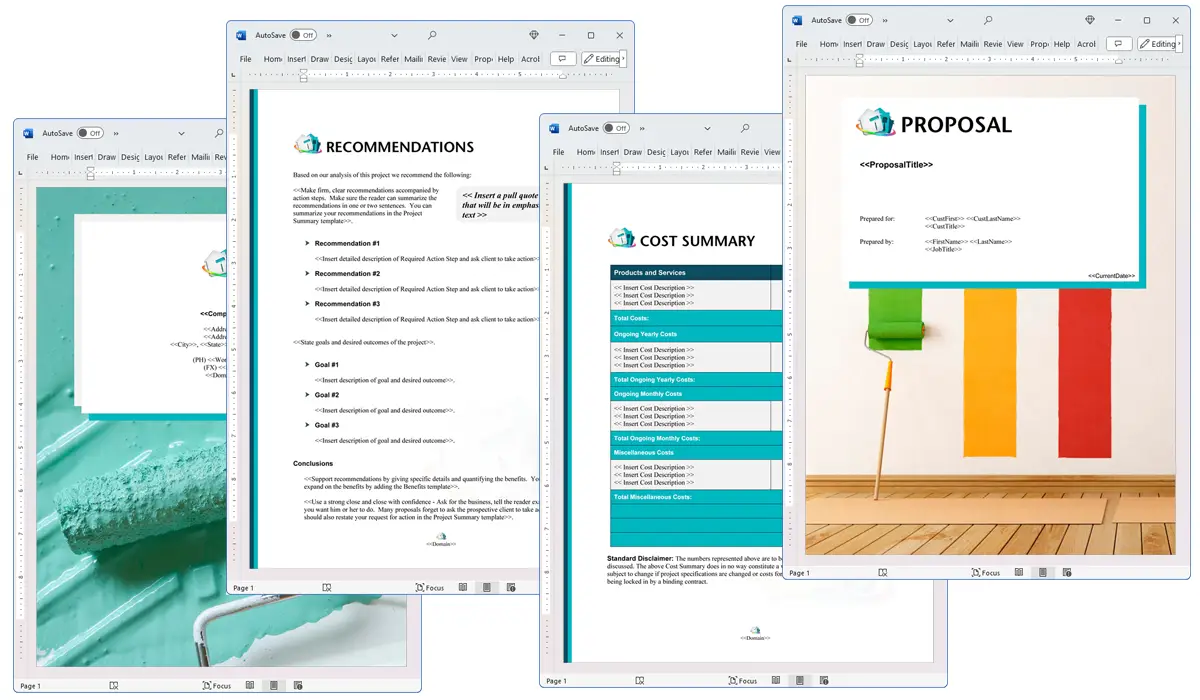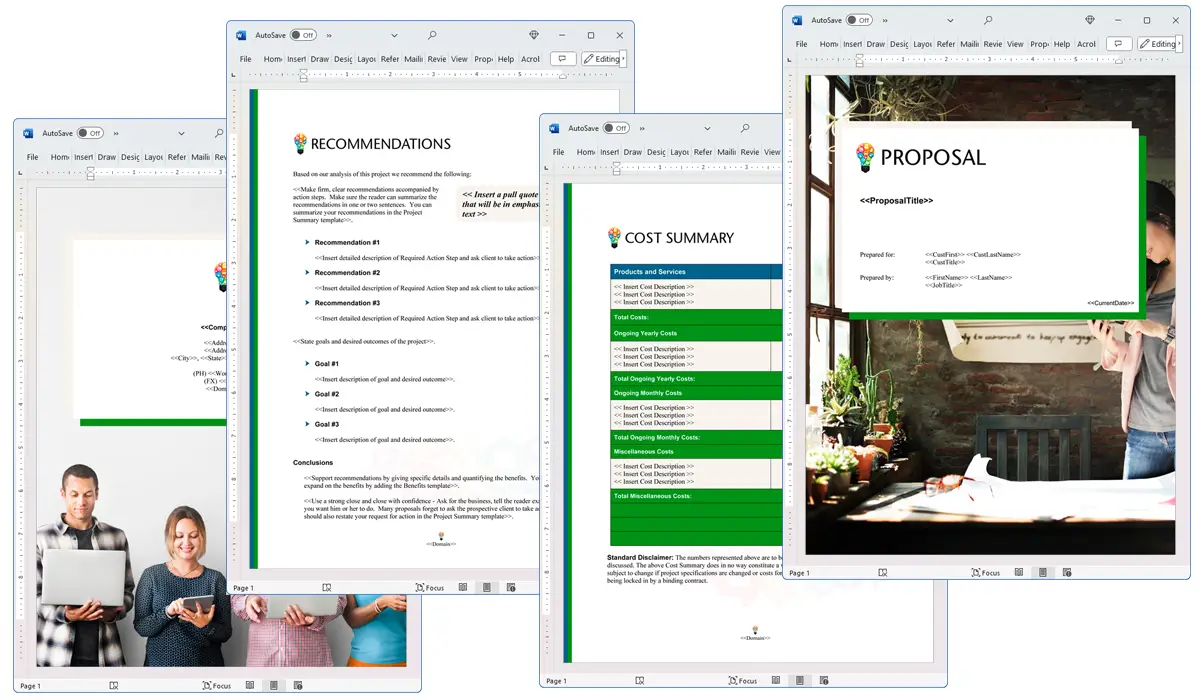What is the Decision Process chapter used for?
Proposal Kit Professional Bundle adds more design themes, all six Contract Packs,
a project management library, and Expert Edition software.

Illustration of Proposal Pack Painter #3
We include this Decision Process chapter template in every Proposal Pack, along with thousands more. You assemble this chapter with others in various combinations to create custom-tailored business proposals, plans, reports, and other documents. Proposal Packs apply custom visual designs to the templates, giving the final documents a consistent professional finish.
 DOWNLOADABLE, ONE-TIME COST, NO SUBSCRIPTION FEES
DOWNLOADABLE, ONE-TIME COST, NO SUBSCRIPTION FEES
Overview of the Decision Process Chapter
In the business environment, drafting a clear and effective proposal is crucial for winning new projects and partnerships. The Decision Process chapter is an important part of such proposals. This chapter enables a company to articulate the methodology it employs to reach significant decisions. Understanding this process helps stakeholders, potential partners, and clients gain insight into the organization's decision-making hierarchy and criteria, which can be critical for the trust and transparency required in business dealings.
How is the Decision Process Chapter Used?
The Decision Process chapter is used in business proposals to detail the systematic approach an organization follows to make critical decisions. It serves to reassure the proposal's recipients that the organization adheres to a structured and thoughtful decision-making process. This can be particularly important in proposals that involve significant investments or complex projects. By explaining this process, a company can demonstrate its commitment to due diligence and planning.
What is Included in the Decision Process Chapter?
Typically, the Decision Process chapter includes:
- A description of the decision-making framework: This outlines the models or theories the organization follows to arrive at decisions, such as SWOT analysis, cost-benefit analysis, or consensus.
- Roles and responsibilities: This section specifies who in the organization has the authority to make decisions and how responsibilities are distributed among different levels of the hierarchy.
- Steps of the decision-making process: A detailed walk-through of the stages involved in making decisions, from identifying the need for a decision to evaluating its outcomes.
- Tools and resources: Information about any tools or software that assist in the decision-making process, such as data analytics platforms or project management applications.
- Impact assessment: Consideration of how decisions might impact various aspects of the business, including financial health, employee morale, and customer satisfaction.
Use Case Examples for the Decision Process Chapter
- A proposal for a large infrastructure project might detail the decision process to show how environmental, economic, and community impacts are considered.
- In a technology upgrade proposal, the chapter could demonstrate the criteria used to choose certain software over others, emphasizing considerations like security features and user-friendliness.
- For a marketing agency pitching to a new client, this chapter might explain how creative concepts are evaluated and selected based on alignment with client objectives.
- In a proposal for venture capital, the Decision Process chapter could outline how potential investments are assessed, focusing on risk management and projected returns.
- When proposing organizational changes, this chapter could detail the process for gathering employee feedback and how it influences final decision-making.
Key Takeaways
- The Decision Process chapter is crucial for illustrating how a company approaches important decision-making.
- It reassures potential partners and clients of the organization's commitment to structure and planning.
- This chapter includes descriptions of decision-making frameworks, roles and responsibilities, and the specific steps involved in making decisions.
- It is applicable in various contexts, from large-scale projects to internal changes, enhancing the proposal's credibility.
- Understanding the Decision Process chapter helps stakeholders gauge the organization's operational and integrity.

Illustration of Proposal Pack Business #22
 What Our Clients Say
What Our Clients SayWorth the extra cost to have both products to sell you product! Easy to use, great presentation! You will make your money back! I’ve been using this product since 2012 and always upgrade for the latest version! I recommend the Proposal Pack Wizard as well!"
One All Tennis Association
 4.7 stars, based on 845 reviews
4.7 stars, based on 845 reviewsRelated Chapters
Document Layouts Using the Decision Process Chapter

The Decision Process chapter and other chapters are integrated into a Word document as illustrated here in the Proposal Pack Social Media #2 design theme. There are hundreds of design themes available, and every design theme includes the Decision Process chapter template.
A proper business proposal will include multiple chapters. This chapter is just one of many you can build into your proposal. We include the complete fill-in-the-blank template in our Proposal Pack template collections. We also include a library of sample proposals illustrating how companies in different industries, both large and small, have written proposals using our Proposal Packs. This template will show you how to write the Decision Process.
We include a chapter library for you to build from based on your needs. All proposals are different and have different needs and goals. Pick the chapters from our collection and organize them as needed for your proposal.
Using the Proposal Pack template library, you can create any business proposal, report, study, plan, or document.
 Ian Lauder has been helping businesses write their proposals and contracts for two decades. Ian is the owner and founder of Proposal Kit, one of the original sources of business proposal and contract software products started in 1997.
Ian Lauder has been helping businesses write their proposals and contracts for two decades. Ian is the owner and founder of Proposal Kit, one of the original sources of business proposal and contract software products started in 1997.By Ian Lauder
 Published by Proposal Kit, Inc.
Published by Proposal Kit, Inc.


 Cart
Cart
 Facebook
Facebook YouTube
YouTube X
X Search Site
Search Site